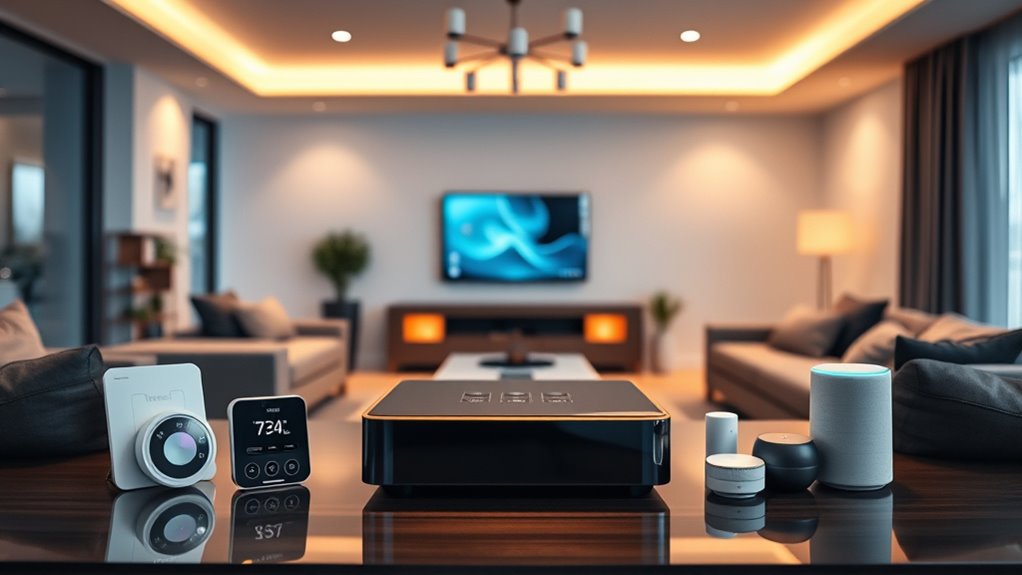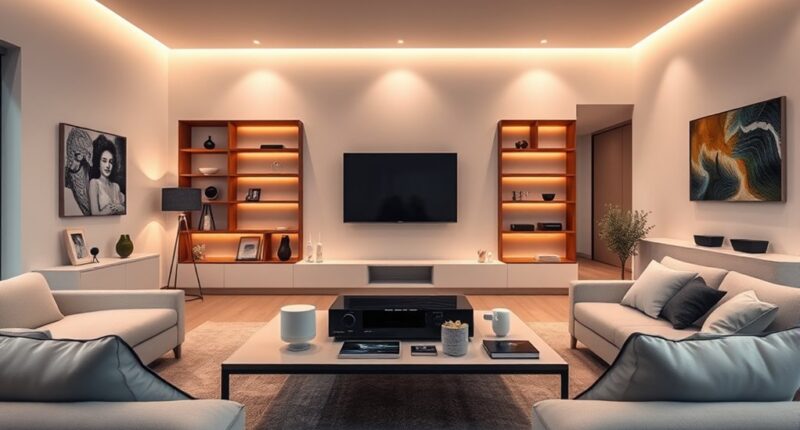If you want to elevate your smart home, I recommend exploring premium hubs like Hubitat Elevation, SmartThings, Homey Pro, and Aqara U100. These hubs support multiple protocols like Zigbee, Z-Wave, Wi-Fi, and Thread, ensuring greater device compatibility. They also offer local processing for faster responses and enhanced privacy. From user-friendly setups to robust automation features, these hubs can truly transform your experience. Keep going to discover the best options for your home.
Key Takeaways
- Supports extensive protocols like Zigbee, Z-Wave, Wi-Fi, Bluetooth, Matter, and Thread for broad device compatibility.
- Integrates with major ecosystems such as Apple HomeKit, Google Home, Alexa, and Samsung SmartThings.
- Offers advanced local processing, automation flexibility, and real-time device control for a reliable smart home experience.
- Features easy setup, user-friendly interfaces, and seamless control through apps, touchscreens, and remote devices.
- Ensures future-proofing with support for emerging standards, multi-device scenes, and energy management integrations.
Hubitat Elevation Home Automation Hub (Model C-8 Pro)
If you’re looking for a versatile and powerful home automation hub that can handle a large number of devices, the Hubitat Elevation C-8 Pro is an excellent choice. It supports over 1000 devices across 100+ brands, including popular ones like Philips Hue, Nest, and Lutron, using protocols like Zigbee 3.0, Z-Wave 800, Wi-Fi, IR, and Bluetooth. The hub offers local control for faster response times, better reliability, and enhanced privacy, even during internet outages. Its advanced automation capabilities let you create complex rules, scenes, and dashboards. While setup can be tricky, active community support helps troubleshoot issues, making it a top-tier choice for serious smart home enthusiasts.
Best For: smart home enthusiasts seeking a versatile, reliable hub capable of managing extensive device networks across multiple protocols with advanced automation features.
Pros:
- Supports over 1000 devices across 100+ brands, offering extensive compatibility.
- Provides local control for faster responses, increased reliability, and enhanced privacy.
- Supports multiple protocols including Zigbee 3.0, Z-Wave 800, Wi-Fi, IR, Bluetooth, and Matter, enabling broad device integration.
Cons:
- Setup and configuration can be complex and may require technical knowledge.
- Managing groups or Matter Wi-Fi bulbs can sometimes lead to connectivity or recognition issues.
- The user interface may be unintuitive, posing a learning curve for some users.
Homey Pro Smart Home Hub for Automation
Homey Pro stands out as the ideal choice for smart home enthusiasts who demand extensive device compatibility and robust automation capabilities. It supports Z-Wave Plus, Zigbee, Wi-Fi, BLE, Infrared, Matter, and Thread, connecting over 50,000 devices from more than 1,000 brands like Philips Hue, Sonos, Yale, Ecobee, and Govee. Its open platform with both official and community apps guarantees broad compatibility, and all data is processed locally for privacy and energy efficiency. The system enables complex automations via Homey Flow, managing everything remotely and providing real-time alerts. Reliable performance and easy setup make it a powerful, versatile hub for elevating your smart home experience.
Best For: smart home enthusiasts seeking extensive device compatibility, advanced automation, and local data processing for privacy and energy savings.
Pros:
- Supports a wide range of protocols including Z-Wave Plus, Zigbee, Wi-Fi, BLE, Infrared, Matter, and Thread, ensuring broad device compatibility.
- Enables complex automations through customizable Homey Flow, with reliable performance and easy setup.
- Processes all data locally, enhancing privacy, reducing cloud dependency, and improving automation speed.
Cons:
- Some regional device support gaps, especially for North American brands and certain Z-Wave thermostats, can limit integration.
- Firmware updates and device integrations can be slow, sometimes taking months or remaining unaddressed.
- Higher price point (~$350–$600) may be a barrier for budget-conscious users, and some users experience delays or connectivity issues with certain devices.
SmartThings Hub 3rd Gen Home Automation Hub
The SmartThings Hub 3rd Gen stands out as an excellent choice for those seeking a versatile, easy-to-setup home automation hub that supports multiple protocols. It connects seamlessly with Zigbee, Z-Wave, Wi-Fi, and cloud-to-cloud devices, making it compatible with a wide range of sensors, lighting, and appliances. I found setup straightforward—just download the app, scan QR codes, and connect via Wi-Fi or Ethernet. The hub offers reliable performance, especially with Ethernet, and integrates well with Alexa and Google Assistant for voice control. Its compact design, night vision camera, and easy device management make it a practical central controller for any smart home.
Best For: homeowners seeking a versatile, easy-to-set-up smart home hub that supports multiple protocols and integrates with voice assistants.
Pros:
- Supports Zigbee, Z-Wave, Wi-Fi, and cloud-to-cloud connections for broad device compatibility
- Easy setup with quick pairing and seamless app integration
- Reliable performance, especially with Ethernet connection, and compatibility with Alexa and Google Assistant
Cons:
- Occasional device disconnects and offline sensor issues reported by some users
- Setup can be challenging for less tech-savvy users or with certain ecosystems
- Limited included accessories (e.g., no Australian power adapter), requiring additional purchases or adapters
Homey Bridge Smart Home Hub for Automation
Looking for a versatile smart home hub that supports multiple communication protocols? The Homey Bridge is designed for seamless automation, supporting Z-Wave Plus, Zigbee, Wi-Fi, BLE, and Infrared, making it compatible with a wide range of devices. It works with Amazon Alexa, Google Home, and Siri Shortcuts (sold separately), enabling voice control and automation flows. Setup is quick via the app, though some users face connectivity issues and device recognition problems. While it can link with popular brands like Philips Hue, Sonos, and Nest, its signal range is limited without upgrading to the Homey Pro. Overall, it’s a flexible but sometimes unreliable option.
Best For: those seeking an affordable and versatile smart home hub with broad device support, despite occasional connectivity and usability challenges.
Pros:
- Supports multiple communication protocols including Z-Wave Plus, Zigbee, Wi-Fi, BLE, and Infrared for wide device compatibility
- Seamless setup via the app with quick initial configuration
- Compatible with popular voice assistants like Amazon Alexa, Google Home, and Siri Shortcuts
Cons:
- Limited signal range requiring additional hardware like Homey Pro for extension
- Notable connectivity and device recognition issues with certain Z-Wave devices and other peripherals
- App interface can be clunky and complex, making automation flow creation difficult
Philips Hue Bridge Smart Lighting Hub
If you want a reliable, full-featured lighting system, the Philips Hue Bridge Smart Lighting Hub is an excellent choice. It supports up to 50 lights and accessories, including indoor and outdoor options, and supports Matter for seamless integration with other smart devices. Using Zigbee technology, it guarantees a secure, stable connection that doesn’t strain your Wi-Fi, so your lights stay reliable even if your internet goes down. You can control your lights remotely via the Hue app, create custom automations, and sync lighting effects with movies, music, or games. Plus, it automatically updates to stay current and works effortlessly with voice assistants and future smart home devices.
Best For: homeowners seeking a reliable, full-featured smart lighting system that integrates seamlessly with other smart home devices and offers customizable automation and entertainment features.
Pros:
- Supports up to 50 lights and accessories, suitable for large or multi-room setups
- Utilizes Zigbee technology for a secure, stable connection that doesn’t rely on Wi-Fi
- Compatible with Matter, voice assistants, and can sync with movies, music, and games for dynamic lighting experiences
Cons:
- Requires the purchase of a separate Hue Bridge for full system functionality
- Limited to Philips Hue lights and accessories, which may be more expensive than generic options
- Setup and customization may be complex for users unfamiliar with smart home technology
MOES ZigBee 3.0 Hub/Wired Gateway for Smart Home
For smart homeowners seeking an affordable yet reliable ZigBee hub, the MOES ZigBee 3.0 Hub/Wired Gateway offers a solid solution. Compact and straightforward, it connects via Ethernet or USB power and covers over 200 meters, making it easy to expand your smart home. Compatible with Tuya ZigBee devices, it works seamlessly with smart lights, sensors, switches, and plugs, supporting integrations with Alexa and the SmartLife app. Customers appreciate its stability and ease of setup, though some note occasional disconnections and language barriers. Priced around $60, it’s a practical choice for expanding your ecosystem without breaking the bank.
Best For: smart homeowners looking for an affordable, reliable ZigBee hub to expand their home automation system with easy setup and broad compatibility.
Pros:
- Stable ZigBee connectivity with a wide coverage of over 200 meters
- Compatible with Tuya ZigBee devices, supporting smart lights, sensors, switches, and plugs
- Easy to set up via Ethernet or USB power, with integration options for Alexa and SmartLife app
Cons:
- Occasional disconnections and device stability issues reported by some users
- Language barrier issues with the hub speaking Chinese, which can affect usability
- Limited compatibility with certain Bluetooth devices and proprietary smart products
The arre Smart Button stands out for its Matter and Thread support, making it an excellent choice for homeowners seeking a highly interoperable and future-proof control device. It works seamlessly with Apple HomeKit and Samsung SmartThings, leveraging Thread for faster, low-latency communication. Setup involves scanning a QR code via the Apple Home app, though it can be tricky, especially with mesh Wi-Fi networks. The button’s magnetic mounting, tactile feedback, and LED indicators enhance usability. However, some users face durability issues like magnets falling out and challenging reset procedures. Despite these drawbacks, its reliable performance and strong integration with Apple HomeKit make it a compelling, versatile smart home accessory.
Best For: homeowners seeking a highly interoperable, future-proof smart home control device that integrates seamlessly with Apple HomeKit and supports Thread for fast, low-latency communication.
Pros:
- Seamless integration with Apple HomeKit and Samsung SmartThings platforms
- Compact design with magnetic mounting and tactile feedback for ease of use
- Thread support enables faster, low-latency device communication
Cons:
- Setup can be challenging, especially on mesh Wi-Fi networks, and reset procedures are cumbersome
- Mechanical durability issues, such as magnets falling out after several months
- Battery life averages around six months, with battery access and replacement being less user-friendly
Sengled Z02-Hub Smart Home Hub (Pack of 1)
Choosing the Sengled Z02-Hub Smart Home Hub makes automating and managing your Sengled smart devices effortless, especially if you want seamless voice control. It connects easily to Google Assistant and Alexa, enabling you to control lights and accessories hands-free. The setup is straightforward—simply connect the hub to your router with the included Ethernet cable and follow the in-app guide. It supports up to 64 Sengled devices, giving you room to expand. Manage everything through the Sengled Home app on iOS or Android, where you can set schedules, group devices, and oversee your entire smart lighting system from one interface.
Best For: homeowners seeking a reliable, easy-to-set-up smart home hub to control and automate Sengled lighting and accessories with voice commands.
Pros:
- Seamless compatibility with Google Assistant and Alexa for voice control
- Easy setup with included Ethernet cable and in-app guide
- Supports up to 64 devices, allowing room for system expansion
Cons:
- Requires a stable Wi-Fi or Ethernet connection for optimal performance
- Limited to Sengled smart devices, restricting cross-brand compatibility
- No built-in Wi-Fi; depends on router connection for operation
SONOFF Zigbee 3.0 USB Dongle Plus Gateway, Zigbee USB Adapter
If you’re building a reliable and flexible Zigbee network for your smart home, the SONOFF Zigbee 3.0 USB Dongle Plus Gateway stands out as an excellent choice. It’s pre-flashed with Z-Stack 3.x.0 firmware and supports ZHA in Home Assistant and Zigbee2MQTT, making setup straightforward. Based on TI CC2652P chips, it delivers strong signal output (+20dBm) and includes an external SMA antenna to reduce interference. Compact and easy to integrate, it supports over 70 devices and offers reliable local control without cloud dependency. Many users find it stable, with excellent range and compatibility, perfect for expanding a smart home Zigbee network.
Best For: smart home enthusiasts seeking a reliable, easy-to-integrate Zigbee gateway for local control and extensive device compatibility.
Pros:
- Plug-and-play with Home Assistant via ZHA and Zigbee2MQTT for flexible automation options
- Strong signal output (+20dBm) with external SMA antenna for enhanced range and reduced interference
- Compatible with over 70 Zigbee devices, ensuring broad device support and reliable performance
Cons:
- Firmware flashing can be complex and may require technical knowledge for optimal setup
- Initial device detection issues reported by some users, often resolved with firmware updates
- Potential interference issues mitigated by using USB extension cables, adding extra setup considerations
Kasa Smart Plug HS103P4, Wi-Fi Outlet with Alexa & Google, 4-Pack
For anyone seeking an easy and reliable way to control multiple appliances remotely, the Kasa Smart Plug HS103P4 offers a convenient solution. This 4-pack Wi-Fi outlet works seamlessly with Alexa, Google Assistant, and IFTTT, so you can control your devices hands-free. No hub is needed—just plug in, connect to your Wi-Fi, and use the Kasa app to set schedules, timers, or turn appliances on and off remotely. It supports up to 15 amps and is UL certified for safety. With a sleek white design and simple setup, it’s perfect for automating lamps, fans, or holiday lights from anywhere.
Best For: Homeowners and renters seeking an easy, reliable way to remotely control and automate multiple appliances without the need for a hub.
Pros:
- Compatible with Alexa, Google Assistant, and IFTTT for seamless voice control and automation.
- Easy setup with a simple app connection to 2.4GHz Wi-Fi, no hub required.
- Supports up to 15 amps and is UL certified, ensuring safety and reliability.
Cons:
- Requires a stable 2.4GHz Wi-Fi connection; not compatible with 5GHz networks.
- Limited to controlling devices within the smart plug’s power capacity, unsuitable for high-power appliances.
- Some users may experience slight delays in remote control depending on Wi-Fi connectivity.
Emporia Vue 3 Home Energy Monitor
The Emporia Vue 3 Home Energy Monitor stands out as an ideal choice for homeowners seeking all-encompassing energy management with professional-grade safety. I appreciate its UL Listed certification, ensuring it meets strict electrical standards in the U.S. and Canada. Supporting up to 16 circuits across various systems, it provides real-time data on energy use, solar, and net metering, helping me identify waste and lower bills. Installation requires caution and professional help, but once set up, I can monitor my home remotely via WiFi through intuitive apps. Its precise measurements and automation capabilities make it a powerful tool for optimizing energy efficiency and safety.
Best For: homeowners seeking comprehensive, real-time energy monitoring and automation to reduce costs and enhance safety with professional-grade certification.
Pros:
- UL Listed for safety and compliance in the U.S. and Canada
- Supports real-time energy data, solar, and net metering for comprehensive insights
- Easy DIY installation with an intuitive app interface
Cons:
- Limited to monitoring up to 16 circuits, which may not cover all circuits in larger homes
- Sensor size and panel space can pose installation challenges
- Interface could benefit from improved navigation and data export features
Lockin Wi-Fi Gateway and Electronic Lock Component for Smart Lock and Lock Box
Looking for a smart lock gateway that offers reliable remote control and easy setup? The Lockin Wi-Fi Gateway (model G30-wifi) fits the bill perfectly. It’s compatible with Q3/Q1 smart door knobs and L1 lockboxes, supporting multiple devices for remote management. Installation takes just two minutes—plug in, connect via app, and you’re ready. The device provides real-time lock status, battery monitoring, activity logs, and supports voice control through Alexa. It enables remote code management for up to four lockboxes, making it ideal for home security or property management. Its compact, durable design guarantees secure, seamless connectivity without plugging directly into outlets.
Best For: Homeowners, property managers, and Airbnb hosts seeking a reliable, easy-to-install Wi-Fi gateway for remote control and management of smart locks and lockboxes.
Pros:
- Quick and easy setup within two minutes with plug-and-play functionality
- Supports remote code management and real-time lock status updates via app and Alexa voice control
- Compatible with multiple devices, allowing control of up to four lockboxes simultaneously
Cons:
- Not compatible with Lockin Veno series locks and lockboxes
- Does not plug directly into outlets, which may require discreet placement behind furniture
- Limited remote code creation capabilities according to some user feedback
Aqara Smart Lock U100, Fingerprint Keyless Entry Door Lock
If you prioritize seamless integration with Apple devices, the Aqara Smart Lock U100 stands out as an excellent choice. It fully supports Apple HomeKit and Apple Home Key, allowing tap-to-unlock via iPhone or Apple Watch even when devices are out of power. The lock also works with other ecosystems like Google Home and Alexa when paired with an Aqara Zigbee 3.0 hub, enabling automation and remote access through the app. With multiple unlock options—including fingerprint, keypad, and mechanical key—and AES-encrypted local storage, it offers both security and convenience. Its sleek design, weatherproof build, and reliable performance make it a top-tier smart lock for Apple enthusiasts.
Best For: Apple users seeking a seamless, secure, and stylish smart lock that integrates effortlessly with Apple HomeKit and supports tap-to-unlock features.
Pros:
- Fully compatible with Apple HomeKit and Apple Home Key for effortless tap-to-unlock via iPhone or Apple Watch.
- Supports multiple unlocking methods including fingerprint, keypad, mechanical key, and temporary passwords, with AES encryption for added security.
- Durable, weatherproof design with long battery life and premium build quality, suitable for various climates and environments.
Cons:
- Some users find the app setup and user management features complex or slightly confusing.
- Auto-lock sensitivity may occasionally cause false triggers, requiring adjustment.
- Requires a Zigbee hub for integration with third-party ecosystems like Google Home and Alexa, adding an extra device to the setup.
SofaBaton X1S Universal Remote with Hub and App
For anyone seeking a thorough remote control that consolidates their home entertainment devices, the SofaBaton X1S Universal Remote with Hub and App stands out. It manages up to 60 IR, Bluetooth, and WiFi devices with a vast code library supporting over 6,000 brands and 500,000 models. The remote replaces multiple remotes, offering customizable activities that automate several commands at once. Its powerful hub with two IR blasters guarantees strong signals from any angle, and voice control integrates seamlessly with Alexa and Google Assistant. While setup can be tricky, its extensive features and automation potential make it a solid choice for those willing to invest the time.
Best For: tech-savvy users who want a highly customizable all-in-one universal remote with extensive device compatibility and automation features.
Pros:
- Supports up to 60 IR, Bluetooth, and WiFi devices with a vast code library for broad compatibility
- Includes a powerful hub with dual IR blasters for strong, 360-degree control and minimal blind spots
- Offers customizable activities, virtual buttons, and API integration for advanced automation and control
Cons:
- Setup process can be complex and challenging for beginners
- Limited support and reliability for Bluetooth-only devices and some streaming boxes
- Customer reviews indicate issues with connectivity, input switching, and overall support, impacting user experience
Smart Home Control Panel Android Touchscreen Hub for Home Automation
The Smart Home Control Panel Android Touchscreen Hub is an ideal choice for those seeking a seamless, centralized interface to manage all their home automation devices. Its high-resolution Android LCD touchscreen offers vibrant visuals and intuitive interaction, making it easy to control lighting, security, and other smart systems. Crafted from durable ABS plastic, it’s lightweight yet sturdy, fitting easily into various electrical panels thanks to its wide voltage support. Compatible with platforms like HomeAssistant and HomeSeer, it provides reliable, continuous operation without batteries. Simple to install with included screws, this hub elevates your smart home experience with a sleek, user-friendly control point.
Best For: homeowners and smart home enthusiasts seeking a reliable, centralized touchscreen hub to easily manage lighting, security, and automation devices.
Pros:
- High-resolution Android LCD touchscreen with vibrant visuals and intuitive interface
- Durable ABS plastic construction that is lightweight and sturdy for long-term use
- Wide voltage compatibility (100-240V) allows seamless integration into various electrical systems
Cons:
- No included batteries, requiring continuous power supply for operation
- Limited to compatibility with platforms like HomeAssistant and HomeSeer, which may require additional setup
- Price and availability may vary across different online and offline stores
Factors to Consider When Choosing Premium Home Automation Hubs

When selecting a premium home automation hub, I focus on protocol compatibility and local processing power to guarantee smooth operation. I also consider how well it supports my device ecosystem and offers automation flexibility, along with how easy it is to set up. These factors help me find a hub that fits my needs and simplifies my smart home experience.
Protocol Compatibility
Have you ever faced compatibility issues with your smart devices? If so, choosing a hub that supports multiple protocols is essential. Look for one that works with Zigbee, Z-Wave, Wi-Fi, Bluetooth, and IR to make sure it can connect with a wide range of devices. Compatibility with emerging standards like Matter is also important, as it promotes interoperability across brands. Additionally, check if the hub integrates seamlessly with popular voice assistants such as Alexa, Google Assistant, and Apple HomeKit for effortless control. Open platforms or support for third-party devices and protocols expand your options further. In conclusion, consider whether the hub can connect with regional or proprietary protocols to cover all your smart home needs. Confirming protocol compatibility simplifies setup and makes your smart home truly flexible.
Local Processing Power
Strong local processing power in a home automation hub guarantees that your smart routines run instantly and reliably, even without an internet connection. This means you won’t experience delays or disruptions when controlling devices or executing complex automations. High processing capability allows the hub to handle multiple devices simultaneously without slowing down, ensuring smooth performance as your smart home grows. It also enhances privacy by processing sensitive data locally, reducing the need to transmit information to cloud servers. Plus, robust processing supports advanced features like custom scripts, virtual devices, and real-time third-party integrations. Ultimately, a hub with strong local processing power provides a more reliable, faster, and secure smart home experience, giving you peace of mind knowing your automation routines are always operational.
Device Ecosystem Support
Choosing a premium home automation hub requires ensuring it supports the ecosystems and protocols you already use or plan to adopt. I look for hubs that seamlessly integrate with major platforms like Apple HomeKit, Google Home, or Amazon Alexa, so my devices work together effortlessly. Compatibility with protocols such as Zigbee, Z-Wave, Matter, or Thread is essential, as it guarantees broad device support and future-proofing. I also check if the hub can connect with third-party platforms or custom automation apps, expanding my options. Supporting the latest standards like Matter improves interoperability among different brands and devices. Finally, I consider whether the hub can handle both native ecosystem devices and regional or third-party products, allowing me to maximize my smart home ecosystem flexibility and avoid vendor lock-in.
Automation Flexibility
When selecting a home automation hub, flexibility in automation capabilities can make a significant difference in how I customize my smart home. I look for hubs that support multiple protocols like Zigbee, Z-Wave, Wi-Fi, and Matter, guaranteeing I can connect a wide range of devices. Advanced automation features, such as complex routines, multi-device scenes, and multi-step workflows, allow me to create tailored experiences. The ability to use custom scripts, virtual devices, and third-party apps adds even more customization options. Support for voice assistants and remote management guarantees my automations work seamlessly across platforms and from anywhere. Plus, compatibility with sensors, timers, and triggers helps me fine-tune routines precisely to my needs, making my smart home both flexible and responsive.
Setup Complexity
The complexity of setting up a home automation hub varies widely, so it’s important to take into account how much technical effort you’re willing to invest. Some hubs are straightforward, offering plug-and-play installation with clear instructions, making setup quick and easy. Others, especially those supporting advanced features like Matter and Thread, involve multiple steps such as app downloads, QR code scans, and network configurations. Wired hubs or units supporting Ethernet connections may require physical setup, including cable connections and placement within your home network. The initial setup time can range from under 10 minutes for simple systems to over an hour for more complex configurations involving multiple protocols and device integrations. Considering your comfort level with technology will help you choose a hub that fits your needs without unnecessary hassle.
Connectivity Reliability
Connectivity reliability is a key factor that determines how well a home automation hub can keep your devices running smoothly. A dependable hub supports multiple protocols like Zigbee, Z-Wave, Wi-Fi, and Matter, ensuring broad compatibility and seamless communication. Strong signal strength, often boosted with external antennas or mesh networks, prevents device dropouts. For critical tasks, wired Ethernet connections offer greater stability and lower latency compared to Wi-Fi, reducing disconnections. Firmware stability and regular updates are essential for fixing bugs and maintaining consistent operation over time. Additionally, a hub that can operate effectively during internet outages through local processing greatly enhances overall reliability. Prioritizing these features ensures your smart home remains responsive, dependable, and resilient under various conditions.
Frequently Asked Questions
How Do Different Hubs Integrate With Various Smart Device Brands?
Different hubs integrate with various smart device brands through compatibility protocols like Zigbee, Z-Wave, or Wi-Fi. I make sure to check a hub’s supported protocols before purchasing. Once connected, I use the hub’s app to add devices, often with automatic detection. This seamless integration lets me control everything from one interface, ensuring my smart home functions smoothly across different brands and protocols.
What Security Features Are Essential for a Premium Home Automation Hub?
Did you know 80% of smart home breaches happen through insecure hubs? I believe essential security features include robust encryption like WPA3, multi-factor authentication, and regular firmware updates. A premium hub should also have intrusion detection and seamless device isolation to prevent threats. These features give me peace of mind knowing my smart home is protected from potential cyberattacks while I enjoy effortless automation.
Can These Hubs Be Customized for Specific Automation Routines?
Absolutely, these hubs can be customized for specific automation routines. I love how flexible they are—allowing me to set up personalized scenes, schedules, and triggers tailored to my daily habits. Whether I want the lights to dim at sunset or the thermostat to adjust when I leave home, these hubs make it simple to create routines that fit my lifestyle perfectly. Customization truly elevates the smart home experience.
How Scalable Are These Hubs for Expanding Smart Home Setups?
These hubs are highly scalable, allowing me to easily expand my smart home setup as I add new devices. I appreciate how they support multiple protocols and integrate seamlessly with various brands, so I can grow without worrying about compatibility issues. Whether I want to add more lighting, security, or entertainment options, these hubs adapt effortlessly, making my smart home more all-encompassing and future-proof over time.
What Is the Average Setup Time for a Premium Home Automation Hub?
Setting up a premium home automation hub usually takes me about an hour or two. It depends on how many devices I want to connect and how familiar I am with the system. I find that following the manufacturer’s instructions carefully and having my devices ready beforehand helps speed up the process. Once everything’s connected and configured, I can enjoy a seamless smart home experience in no time.
Conclusion
Choosing the right premium home automation hub can truly transform your smart home experience. Did you know that homes with integrated automation save up to 30% on energy costs? That’s a powerful incentive to invest in a hub that fits your needs. By selecting a top-tier hub, you’re not just upgrading convenience—you’re enhancing security, efficiency, and comfort. Take your smart home to the next level and enjoy the seamless lifestyle you deserve.





![SmartThings Hub 3rd Generation [GP-U999SJVLGDA] Smart Home Automation Hub Home](https://m.media-amazon.com/images/I/21hChu0ounL._SL500_.jpg)



















